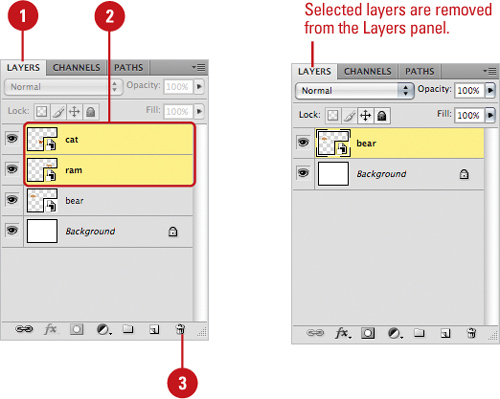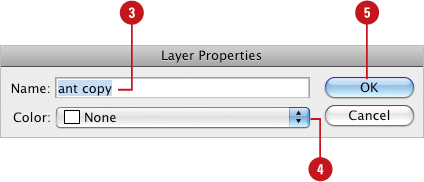1. Deleting Layers
While
Photoshop lets you add layers to a document (up to 8,000), it also lets
you delete layers. Remember that once you’ve deleted a layer and saved
the document, there is no way to recover the deleted layer. However,
while the document is open, there is always the chance of recovering the
deleted layer through the History panel. You can delete shown or hidden
layers using different commands. If you have some empty layers, you can
delete them all at once using the Delete All Empty Layers command (New!) on the Scripts submenu on the File menu.
Delete Layers
1. Select the Layers panel.
 |
2. Select the layers you want to delete.
|
3. Click the Delete Layer button on the Layers panel, and then click Yes.
Did You Know?
You can delete layers from the Layers panel by dragging. Click the layers you want to delete, and then drag it to the Delete Layer button.
You can delete hidden layers from the Layers panel.
Select the Layers panel, click the Layers Options button, and then click Delete Hidden Layers.
You can delete empty layers from the Layers panel.
Click the File menu, point to Scripts, and then click Delete All Empty Layers (New!). |
2. Changing Layer Properties
The
Layer Properties dialog box gives you control over two very important
characteristics of a layer: the layer’s name and its identifying color.
For example, if you’re working on a document with 20 layers and you’re
not naming the layers, after a while you’ll lose track of each layer’s
contents. When you name your layers, you have a visual identifier of the
information contained within that specific layer (assuming you name the
layer correctly). In addition, you can use the Colorize option to apply
a color to a specific group of layers—coloring all the type layers red,
for example. Layer properties may not seem that important, but they go a
long way towards helping you organize a complex, multi-layered
document.
Change Layer Properties
1. Select the Layers panel.

|
2. Click the Layers Options button, and then click Layer Properties.
Timesaver
Hold down the Alt (Win) or Option (Mac) key and double-click a layer name to open Layer Properties.
|
3. Change the name of the layer.

|
4. Click the Color list arrow, and then click a layer color.
|
5. Click OK.
|